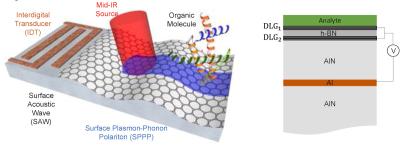Universidad Politécnica de Madrid researchers have reported the development of an electrically tunable graphene-based biosensor that leverages sound waves to provide unprecedented infrared sensitivity and specificity at the single layer limit. By precisely matching the tunable graphene plasmon frequency to target molecular vibrations, even faint spectral fingerprints emerge clearly.
This acoustically activated approach enables precise in situ study of angstrom-scale films, unlocking new infrared applications across chemistry, biology and medicine.
“Graphene has emerged as an exceptional platform for infrared spectroscopy and sensing,” explains lead author Raúl Izquierdo-López. “Its two-dimensional nature confines light far beyond what metals can achieve. And unlike metals, graphene’s optical properties can be electrically tuned.”
The team stacked two graphene sheets around a thin hexagonal boron nitride spacer on an aluminum nitride substrate. The team modeled the biosensor using a transfer matrix method that considered graphene as a conductive interface between dielectric layers.
By tuning the Fermi level of double graphene layers with electrical gating, the scientists tailored the hybrid graphene plasmon-hBN phonon modes to resonate across infrared frequencies linked to common biological bond vibrations. They then activated the integrated surface acoustic wave device to produce nanoscale sound waves that dynamically “rippled” the graphene stacks. This virtual diffraction grating coupled the propagating graphene polaritons to infrared light at target frequencies without needing permanent nanostructures.
Next, they activated the integrated surface acoustic wave device to produce nanoscale sound waves that propagated across the graphene stacks. This dynamic rippling formed a virtual diffraction grating that coupled the graphene plasmons to free space infrared light at tunable frequencies without fabricating permanent nanostructures.
Simply by gating the Fermi level, the researchers could scan for molecular vibrations of interest, similar to tuning a radio dial. When the graphene plasmon frequency overlapped with a molecular resonance, a transparency window emerged, indicating strong coupling. This signaled the detected molecule’s presence louder than ever before.
To demonstrate sensitivity, the team analyzed nanometer organic films of the semiconductor CBP, protein bilayers combining the recombinant protein A/G and goat anti-mouse IgG antibodies, as well as single layers of the valine gramicidine A peptide which forms conductive ion channels in lipid membranes. The virtual diffraction biosensor effectively fingerprinted all specimens across coupling regimes from initial plasmon broadening to full Fano resonance interference.
“This tunable, non-destructive and reusable technology provides specificity and sensitivity unmatched by standard infrared and plasmonic techniques,” says Dr. Pedrós. “It opens doors for precision infrared study of fragile biomolecules and continuum-scale lab-on-chip sensing without microfluidics.”
The researchers plan to further enhance sensitivity by integrating state-of-the-art high mobility graphene. With optimized materials and a refined acoustic wave mixing technique that suppresses noise, they aim to achieve single molecule infrared spectroscopy within the decade.




